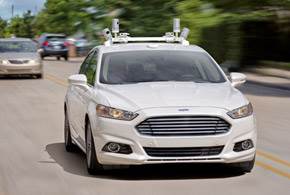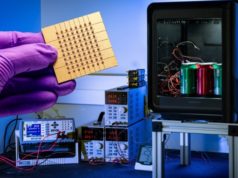NEWS ANALYSIS: Ford Motor Co. channels Apple as it ramps up a Silicon Valley office, locks in technology providers and carefully plans its roll-out of autonomous cars.
The Ford Motor Company is making a major step into autonomous vehicles, but it’s moving carefully into this automotive technology.
The company announced on August 16 that it will begin high-volume production of fully autonomous vehicles in 2021 and will market them for ride sharing. Ford also announced that it has locked up agreements with four startups that have developed technology critical for the success of autonomous cars.
In a video announcement about the company’s plans, Ford President and CEO Mark Fields said these will not be standard car designs with autonomous technology added on.
“There will be no steering wheel, no gas pedal and no brake pedals. A driver is not going to be required,” Field said in his video presentation.
Fields predicted that Ford’s autonomous cars would have as significant an impact on society since the company developed the moving assembly line 100 years ago. “When we step back and we take a look at how we can make the most difference in people’s lives over the next 100 years, we see the autonomous car changing the way the world moves.”
Ford isn’t alone in getting an autonomous car ready for real-world use. In January, General Motors announced a plan with car-sharing service Lyft to produce autonomous cars, although a specific target date wasn’t announced. In addition, Uber is reportedly in talks with Mercedes-Benz to begin tests with autonomous version of it S-Class cars.
For its part, Mercedes Benz has already tested autonomous operations with such a vehicle when it drove an S-Class on the same route originally taken by Bertha Benz, wife of Carl Benz, on history’s first automotive road trip. Of course, there were important differences, such as paved roads, in the more recent drive.
But Ford is planning something that’s much more innovative than a single trip over a known course. By using a car sharing service such as Lyft or Uber, Ford is planning a series of trips chosen by riders in a large area.
While there will be restrictions and limitations, what this means is that a customer can specify a pickup point in the city where the autonomous car is operating and pick a destination. The job of the car is to pick up the customer and deliver them to the destination.
The advantage to using a ride sharing service such as Uber or Lyft is that Ford will have a significant amount of control over where the car can go and the conditions under which it can operate.
Because the customer is required to provide their pickup point and their destination when ordering their ride, Ford can make sure they send a car that can operate in the required area. It also means that Uber or Lyft can send a car with a human driver if the customer needs to travel outside of the autonomous car’s safe operating area.





![[CES 2026] Quest For Perfect Color…Samsung To Push](https://loginby.com/itnews/wp-content/uploads/2025/12/CES-2026-Quest-For-Perfect-Color…Samsung-To-Push-100x75.jpg)

